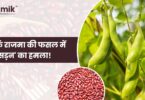
Pulses occupy an important place in Indian agriculture. In India, pulses are grown over an area of 23.8 million hectares with a total production of 18.6 million tonnes. The average yield of pulses in India is about 735 kg/hectare. The country needs to produce 405 million tonnes of additional pulses for meeting the domestic requirement and this can be possible only if we develop high-yielding, short-duration, drought, and insect pest resistance varieties of pulses. In the rainy season, pulses like green gram, black gram, pigeon pea, and cowpea are the most important and leading pulse crops in India. Chickpeas, lentils, Lathyrus, field peas, and kidney beans are the important pulse crops grown during the winter season. However, green gram, black gram, and cowpea are grown in both spring and rainy seasons. Pulses are generally grown in irrigated as well as rain-fed areas and belong to leguminaceae family. (Main growing areas of pulses in India are Madhya Pradesh, Uttar Pradesh, Gujarat, Maharashtra, Karnataka, and Rajasthan. Madhya Pradesh is the leading state in India in pulses, in terms of cultivated area and productivity.
Factors Responsible for Low Yield of Pulses
- Delayed sowings/plantings
- Low seed rate resulting in poor crop stands
- Poor weed management during crop growth
- Inefficient irrigation and rainwater management
- Large-scale monoculture and non-inclusion of pulses in cropping systems
- Lack of consideration of previous cropping in the same field
- Inadequate plant protection.
- Non-availability of seeds of HYVs at affordable prices and at the appropriate time
- Lack of more efficient N using genotypes
- Imbalanced use of fertilizers
- Poor management of secondary and micronutrients, mainly 5, Zn, Mn, Fe, and B.
India has only three percent of the world’s land resources and five percent of its water resources. Yet, the Indian agriculture system supports 18 percent of the world’s population. Since resources, viz. land, water and energy are limited, scarce, costly, and have competing demands for urbanization industrialization, and meeting farming needs. Further: the degrading of soil health is posing major concerns for agricultural sustainability. Low soil organic matter and imbalanced use of fertilizers are affecting pulse crops’ productivity. A deficient monsoon followed by a further dry spell for the past few years has affected pulses production. The production of pulses in India has remained insufficient making us dependent on imports. The demand for these food commodities is expected to increase in the future substantially. India is the world’s largest producer, importer, and consumer of pulses Our annual import bill for pulses is Rs 100,000 million. Thus, there is a great need for increased production of pulses as per capita availability of pulses is only 37 g/day as against 54 g/day required to fulfill the protein requirement under changing climate scenario, more emphasis shall be given to achieving the target of 24 million tonnes of pulses production by 2020 so as to make the country self-sufficient and reduce the burden of import bill substantially Further, pulse seed production hubs are being developed in various regions to ensure availability of quality seeds of pulses to farmers.
The per capita availability of pulses has progressively declined from 65 g/ day in 1961 to merely 39.4 g in 2011, whereas, the availability of cereals has gone up from 399.7 to 423.5g. For a country that faces persistent protein inflation and has a preference for a vegetarian diet, pulses are the most economical source of vegetable protein higher consumption of pulses will help address the scourge of pervasive malnutrition caused by protein deficiency among large sections of the Indian population.
National Food Security Mission (NFSM) and Pulses
The government has started National Food Security Mission (NFSM) for food and nutritional security and for the promotion of the cultivation of pulses and other foods have been grains. Recently more states covered under National Food Security Mission. Under National Food Security Mission pulses cultivation has been started in Jammu & Kashmir, Himachal Pradesh, Uttrakhand, and all the North East states. Salient points of the National Food Security Mission are given below.
Seven Crops of Rice, Wheat, Pulses, Jute, Sugarcane, Cotton, and Coarse Cereals are covered under NFSM.

Post Views: 221








Leave a Comment